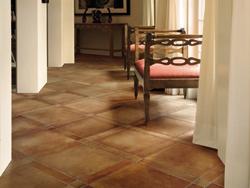Making Money With Ceramic - 08 Retailers' Guide
Ceramic and porcelain tile use here in the U.S. has tripled in the last 12 years. Consumers are drawn to its natural elegance, not to mention its durability. And of all the flooring products you sell, tile is the only one where you can also add the walls, countertops, hearths and tub surrounds to your order. Think of it. Most flooring goes on one surface, but porcelain and ceramic tile are at home on multiple surfaces of the home.
Tile gives you the greatest opportunity to show off your design taste and create custom spaces. Given the numbers of styles, colors, shapes and sizes of tile from all over the world, the opportunity for creativity on your part and the customer’s is endless. That goes for mosaics, decorative inserts, stone, metal, glass and all other shapes and sizes gaining in popularity, like large format tiles and the hot new look in horizontal tile.
Learn to talk about grout lines. Not only should you position them as a design accent but you should also know that with the trend of larger format tiles and rectified edges, thinner grout lines are now in vogue. Larger format tiles and fewer grout lines make a room appear larger.
This is another area where keeping a photo album of recent customer installations can be a great visual selling tool.
And don’t forget to mention that you also sell radiant heat packages that make the floor warm in the winter and use very little energy.
|
SECRETS TO HIGH MARGIN SELLING...STOP "DOWN SELLING" |
|
Starting with bottom priced product and "working your way up" leaves a bad taste in the customer's mouth. Show the best, the most unusual or the most fashionable products first. Have plenty of home fashion magazines to refer to and give your fashion ideas credibility. And don't ever forget to show them up-to-the-minute colors, too. |
Copyright 2007 Floor Focus
